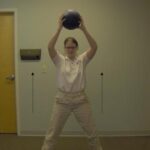Torticollis – the name sounds like a terrible disease for turtles, but it’s not. Sometimes called “wryneck,” babies with torticollis have a limited range of motion in their neck. You may notice a baby tends to favor looking in one direction over the other or is completely incapable of looking in the other direction at all.
There are a variety of reasons why a baby may develop torticollis. It could be due to a mutation in your baby’s genes during development, it could be acquired in-utero or during delivery due to damage to the nervous system, spine, or muscles, and lastly it could be due to the position your baby lays during feeding (this was the case for my baby) or sleeping.
When my baby was getting her routine well-child check-up at two months old, the doctor noticed something was a little off. He laid her down and saw that she was only looking one direction, no matter if I was standing in front of her or calling her name from behind. He tried gently forcing her head in my direction, but it just sprung right back into place! I had noticed she favored looking in one direction over the other before the appointment, but I never thought anything of it until then. That’s when the doctor told me about torticollis. Not only was my daughter unable to move her neck properly, but her muscle tone was extremely hypertonic, or rigid. These two combined characteristics can be an indicator of a serious condition called cerebral palsy, so we were referred to see a specialist immediately.
In the end, my daughter didn’t have cerebral palsy, but the specialist told me to try four things to help with my daughter’s limited range of neck motion:
1) While your baby is laying flat on her back and looking straight at you, take her head and gently force their right ear toward their right shoulder and hold for 10 seconds. Stop and repeat on the other side. It is important to do this on both sides and not just the affected side — you want your baby as evenly stretched out as possible. Do this three times on each side at every diaper change.
2) In addition to doing exercise number one, take your baby’s head and gently force their head to look in one direction. It will be as if you are trying to touch their chin to their right shoulder, hold for 10 seconds, stop, and repeat on the left side. This should also be done in sets of three.
3) While playing on the floor with your baby, lay them on their back and place all their toys on the side of their body they have difficulty turning. This will motivate your baby to do her own stretching.
4) Reposition your baby when they feed or sleep so they turn their head on the affected side.
If everything above fails, your doctor may refer your baby to a pediatric physical therapist.
I realized that I had been feeding my daughter her bottle from the same direction since she was born. I’m almost confident that is why my baby’s neck muscles were uneven. I alternated which side I fed her on (in addition to the other exercises), and in less than one month you couldn’t tell she had torticollis!





